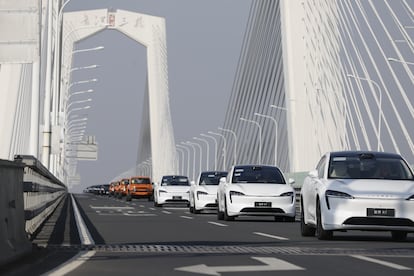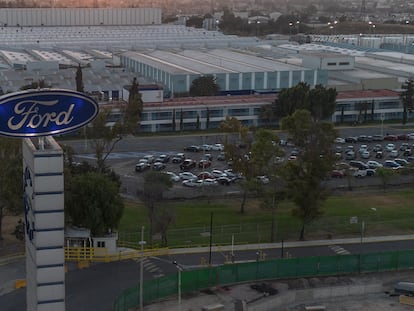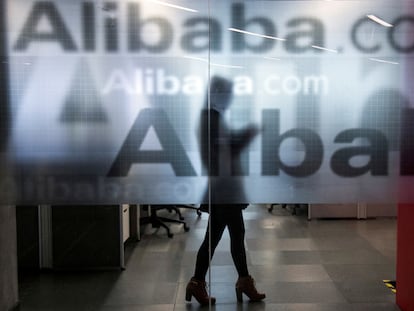This is how cheap Chinese cars are conquering the world
US tariffs are failing to halt the rise of cars from the Asian giant, especially in emerging markets, and could even accelerate it

Donald Trump wants to keep Chinese carmakers out of the U.S., but that won’t stop them from taking over the rest of the world. They already are.
From Bangkok to Johannesburg to São Paulo, the streets are increasingly jammed with inexpensive compacts, crossovers and SUVs made by companies like Great Wall Motor Co., BYD Co., Chery Automobile Co. and SAIC Motor Corp.
While the Trump administration is expected to shield the U.S.’ Big Three from Chinese rivals at home, and Canada and the European Union have placed tariffs on Chinese-made electric vehicles, buyers in emerging markets have welcomed Chinese cars and trucks with open arms — posing a new threat to growth-hungry global automakers.
Oscar Mabuela, a 29-year-old web designer living in South Africa, is the sort of customer that auto executives in faraway cities like Detroit, Tokyo and Wolfsburg have long coveted. Shopping for a new car this year, he considered a Volkswagen Polo hatchback, one of the top-selling vehicles in the country — but got cold feet over fears of hijacking or theft.
Instead, he bought a recent model year gasoline-powered Haval Jolion Super Luxury SUV from Great Wall for 350,000 South African rand ($19,300). A brand new 1.5-liter Jolion starts at $25,000, less than an equivalent 1.0-liter VW Polo’s $27,500 sticker price.
“I get to have all the tech that are extras on known brands,” Mabuela said.
Mabuela isn’t alone. Buyers like him have helped Chinese automakers grab market share at astonishing speed. In South Africa, China-made vehicles account for nearly 10% of sales, or about five times the volume sold in 2019. In Turkey, Chinese brands claimed an 8% share in the first six months of 2024, up from almost none in 2022. In Chile, they have accounted for nearly a third of auto sales for several years running.

China sends more vehicles abroad than any other country, and its passenger car exports surged nearly 20% to 4.9 million in 2024 alone, according to the China Association of Automobile Manufacturers — from less than one million in 2020.
“Chinese automakers have pushed into lots of global markets with high quality and competitively priced vehicles,” said Abby Chun Tu, a Shanghai-based auto research analyst at S&P Global Mobility. “It’s the same strategy that worked for South Korean and Japanese brands, but they also have the advantage of advanced software and lots of features — even in their mass-market models.”
Uneasy giants
Leaders in the U.S. and Europe have long been concerned that China could become a dominant seller of electric vehicles (EV). BYD has stoked those fears by unveiling a lineup of electric vehicles it says can charge almost as fast as it takes to refuel a regular car, sending the company’s shares on Tuesday to a record high in Hong Kong. Competitor Xiaomi Corp., meanwhile, hiked its annual EV delivery target after posting its fastest revenue growth since 2021. Yet Chinese automaker association’s data show gas-powered vehicles accounted for nearly 80% of total vehicle exports last year.
Many underdeveloped markets don’t have charging stations or a reliable enough electrical grid to support fully electric models. But Chinese automakers have found in those places a ready market for gas-powered cars that they can no longer sell at home in large volumes.
Global market share for Chinese automakers outside their home country is expected to climb to 13% in 2030 from 3% today, according to AlixPartners. Including China, that worldwide share jumps to 33%, and in Africa and the Middle East it’s projected to hit 39% by then.
At a conference in February hosted by investment firm Wolfe Research, the heads of Ford Motor Co. and General Motors Co. acknowledged the competitive pressure being brought to bear in developing markets. “Our operations overseas are very fit, but the Chinese are coming to those markets now, globalizing the supply chain,” Jim Farley, Ford’s CEO, told investors. “In emerging markets like India, especially South America, they’re being dominated by the Chinese,” he said, referring specifically to China-made EVs.
Ford has ceased vehicle production in Brazil, where its former factory has been acquired by China’s BYD. The carmaker has drawn a line in the sand, however, for its business in South Africa and Thailand, with plants that produce hundreds of thousands of Ranger pickups annually. “We have to think about future-proofing that,” Farley said.
GM also views the Chinese as a serious threat. But CEO Mary Barra is picking her battles. Meanwhile, the Detroit-based carmaker is opportunistic enough to export models made by its own Chinese joint venture to emerging markets like Brazil. Barra said working with Chinese automakers on some products allows GM to better compete in markets “where the Chinese are very present.”
Stellantis NV, which owns the Chrysler and Ram brands, also is cooperating with a Chinese partner in Europe and plans to introduce its models to the Middle East and South America as well.
The Jeep maker’s market share in Latin America still dwarfs that of its nearest Chinese competitor, accounting for a fifth of vehicles sold, according to researcher Jato Dynamics. By comparison, Chery has the largest share among Chinese manufacturers, at 2.1%.
At the same time, last fall the company blamed competition from China for a 30% third-quarter drop in Asia-Pacific region shipments.
Building buzz
Savvy marketing has also helped Chinese automakers get a leg up. In Brazil, where Chinese cars have become as familiar a sight on the roads as Chevy and Toyota models, Great Wall created a page on Mercado Livre, a popular online marketplace, and created ads starring Alok, a top Brazilian musician and DJ. Rival BYD pitched its cars in an ad featuring footage of soccer great Pelé, a Brazilian national hero.
While such campaigns have helped generate buzz, low prices remain the primary draw. Luiz Palladino, 61, an engineer who has owned GM and Honda vehicles in the past and currently drives a Haval H6 EV, compared the car with much more expensive luxury cars.
“The moment I got into the car I thought: It’s in line with BMWs, Audis, with top-notch car finishing,” he said. “It has everything I want.”
Chinese brands got a toehold in Brazil in 2015, when the government made electric vehicles and hybrids exempt from a 35% import tax. To get around reinstatement of those duties, BYD and Great Wall are now building plants in Brazil — on sites where Ford and Daimler once ran facilities.
“The Chinese found a great opportunity to transform Brazil into a hub for the westernization of their vehicles,” said Ricardo Roa, partner-leader of the automotive sector at KPMG Brazil. “From Brazil, it’s easier to reach other South American markets: Argentina, Chile, Colombia and even Peru.”
Some car shoppers in Brazil say they’ve shied away from Chinese models out of concerns about reliability and service, as well as the availability of parts. Paula Barros, a financial product manager in São Paulo, gave up on plans to buy a China-made EV on worries about insufficient charging infrastructure and potential issues acquiring parts when something breaks.
“Some replacements need to be imported,” she said, “and if something happens to my car, I’d have to wait 30 to 60 days for the component to arrive.”
Electrical surge
Asia’s biggest automakers are also trying to fend off Chinese upstarts. Toyota Motor Corp. enjoys a 17.4% share in the Middle East and Africa, but is being chased by Chery and Geely, which have claimed shares of 5.3% and 2%, respectively, according to Jato Dynamics. Toyota is feeling similar pressure in Southeast Asia, where it controls 35.7% of the market but Geely and SAIC are grabbing respective shares of 5.1% and 1.4%.
As in Brazil, China has taken advantage of policies designed to encourage sales of electric vehicles to expand its presence in Thailand’s auto market. The Chinese brand share in the country, long known as “the Detroit of Southeast Asia,” has grown to 13.3% as of the last quarter of 2024, up from just 5.5% two years earlier, according to S&P Global Mobility. More telling: China’s share of Thailand’s EV market in that same timeframe has mushroomed to 71%, up from 22% in 2022.
Thailand cut import taxes on EVs, added buyer subsidies for them and gave out big tax breaks for investments in plants. As a result, EV sales skyrocketed by more than 600% in 2023 from the previous year to 73,568 units, seizing almost 9.5% of total passenger car sales, according to the Federation of Thai Industries. EV sales dipped slightly to 66,732 last year, but their share of overall vehicle purchases rose to just under 12%.
Toyota and other Japanese carmakers, which spent decades building up gas-powered vehicle production investment and infrastructure, were slow to adapt. Subaru Corp. stopped making cars in the country last year and Suzuki Motor Corp. plans to shutter its Thai plant by the end of 2025. Nissan Motor Co. also will close one of two vehicle assembly lines in Thailand this year. That has left an opening for lesser-known Chinese rivals.
On the first day of the 11-day Bangkok Motor Expo in late November, Toyota, Ford and Honda Motor Co. shared floor space with BYD, Great Wall, SAIC Motor’s MG and Geely, which was making its debut in the Thai market. Wiyawit Petra, a 57-year-old businessman, said BYD’s global reputation, local manufacturing footprint and low prices have opened him up to the idea of trying something different.
“I’ve driven Toyota and Honda all my life, but I want open my heart to something new now,” he said during the expo, eying a BYD plug-in hybrid Sealion 6 SUV. “It’s also affordable, so it’s worth the risk.”
Sign up for our weekly newsletter to get more English-language news coverage from EL PAÍS USA Edition
Tu suscripción se está usando en otro dispositivo
¿Quieres añadir otro usuario a tu suscripción?
Si continúas leyendo en este dispositivo, no se podrá leer en el otro.
FlechaTu suscripción se está usando en otro dispositivo y solo puedes acceder a EL PAÍS desde un dispositivo a la vez.
Si quieres compartir tu cuenta, cambia tu suscripción a la modalidad Premium, así podrás añadir otro usuario. Cada uno accederá con su propia cuenta de email, lo que os permitirá personalizar vuestra experiencia en EL PAÍS.
¿Tienes una suscripción de empresa? Accede aquí para contratar más cuentas.
En el caso de no saber quién está usando tu cuenta, te recomendamos cambiar tu contraseña aquí.
Si decides continuar compartiendo tu cuenta, este mensaje se mostrará en tu dispositivo y en el de la otra persona que está usando tu cuenta de forma indefinida, afectando a tu experiencia de lectura. Puedes consultar aquí los términos y condiciones de la suscripción digital.

